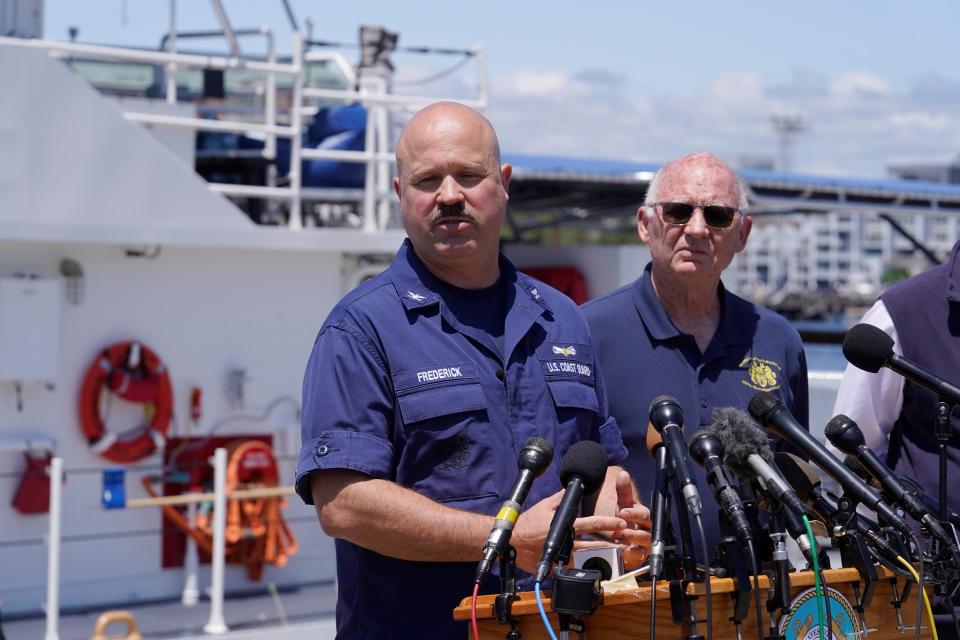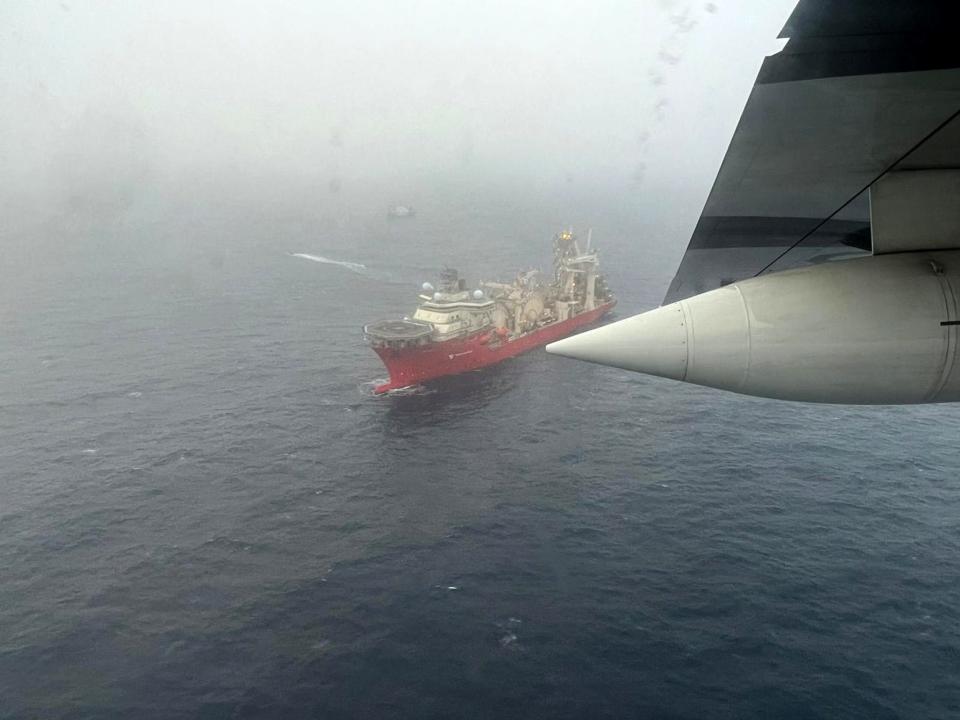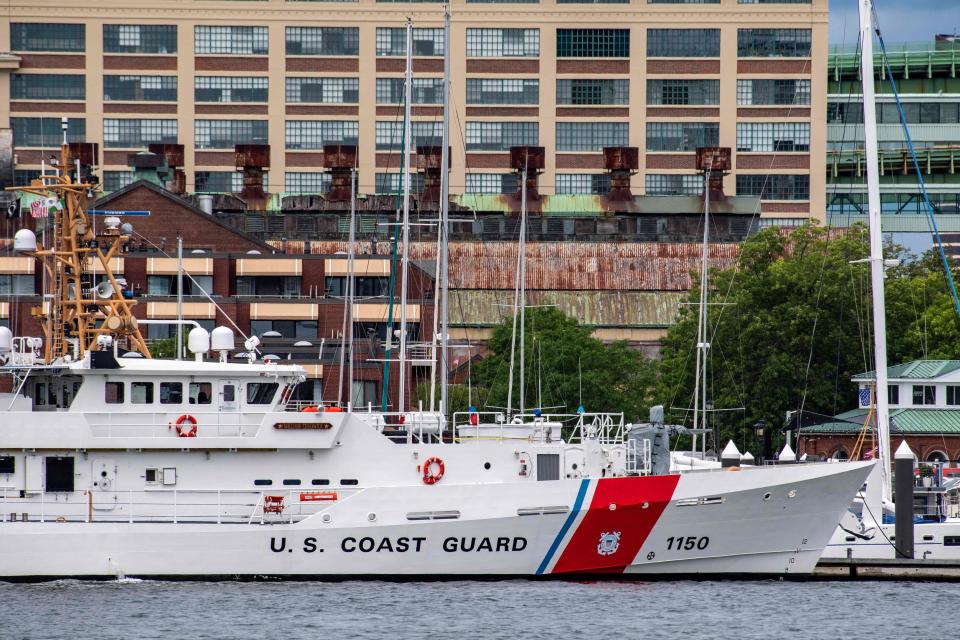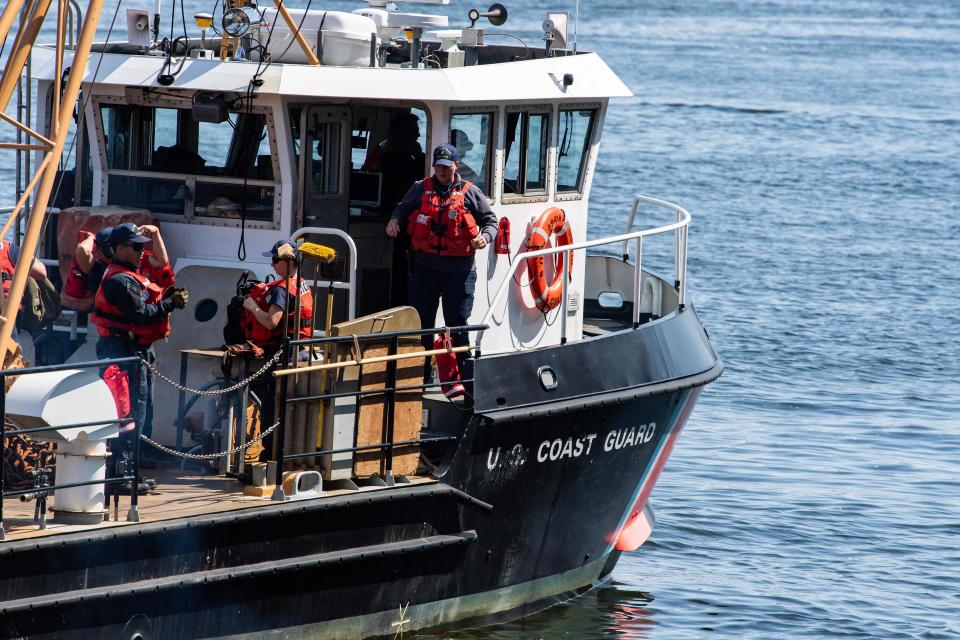For Coast Guard, search for tourist sub near Titanic is a rescue unlike most others
A search for a vessel like Titan – the tiny submersible that vanished in the North Atlantic – is at the core of the mission for the U.S. Coast Guard, yet is unlike the thousands of other searches the seafaring agency runs each year.
The 22-foot underwater craft lost contact with the ship that launched it Sunday on a dive that aimed to reach the wreck of the Titanic. Since then, the search has commanded global headlines as the world counted down the craft’s dwindling hours of oxygen supply.
Aboard the submersible were a British adventurer, two members of a Pakistani business family, a Titanic expert and the CEO of OceanGate, the private company that operates the vessel.
The U.S. Coast Guard is no stranger to responding to mariners in distress. It conducted nearly 17,000 search-and-rescue missions in 2020. But most of those are for surface vessels. This one is 900 miles offshore of Cape Cod, Massachusetts, and, though no one knows where the craft is now, its destination was a wreckage site more than 2 miles deep.
And the nature of this search, for wealthy patrons on a risky adventure, has rekindled longstanding discussions about who pays the costs of rescues when people choose dangerous journeys.
For rescue crews, however, the only concern is saving lives. Aided by a multinational group of ships, planes and undersea equipment, search crews know the clock is ticking.
“The next few days will be critical,” retired U.S. Navy Vice Admiral Robert Murrett, now deputy director of the Institute for Security Policy and Law at Syracuse University, told USA TODAY.

Who is part of the search?
The Coast Guard is part of a “unified command” that includes the U.S. Navy, Canadian Coast Guard and OceanGate Expeditions.
Five vessels now search the ocean's surface, with another five expected to join in the next day or two, Capt. Jamie Frederick, the First Coast Guard District response coordinator, said Wednesday. Also on scene are several private vessels including a Bahamian research ship.
By air, three C-130 aircraft and three C-17 transport planes from the U.S. military are scouring the sea in addition to Canadian military aircraft with sound-sensing equipment.

Underwater, two remotely operated vehicles, or ROVs, were searching for Titan with several more set to arrive by Thursday with the capability to scan the sea floor, all coordinated by U.S. Navy experts.
Aiding the search was a French team specializing in ROVs and an expert submariner from the British Royal Navy. Also helping are experts including some from the Woods Hole Oceanographic Institution.
The submersible targeted depths far below where typical military submarines operate. The Navy's Underwater Rescue Command, which focuses on submarine rescues, can work at depths of up to 2,000 feet. The Titanic wreck sits at more than 12,000 feet.
How does the Coast Guard search for missing vessels?
When the Coast Guard scrambles ships or aircraft, it’s often to respond to a distressed vessel with a known location, often because people aboard can issue a call for help. The rescues are typically in near-coastal areas.
In more than 90% of search and rescues, Coast Guard ships or aircraft are on the scene within two hours, according to a 2020 Coast Guard performance report.
But missing ships or people require searching vast stretches of ocean. In December, for example, the Coast Guard launched a search for two missing sailors last seen off the North Carolina coast. Cutters, planes and a helicopter searched an area that would stretch from Florida to New Jersey. Even then, the sailors were found only by luck, from a passing cargo ship.

Search crews work by taking last-known positions – whether through a signal or sighting – and calculate currents, winds, sea states and other factors to determine the search radius, said Chris Boyer, the executive director of the National Association for Search and Rescue, a nonprofit education, training and advocacy group.
“They do a lot of math,” he said.
Planes and ships use radar, infrared cameras and night vision to scour the white-capped ocean.
Where are they searching for the submersible?
The surface search area is twice the size of Connecticut, as well as nearly 2 1/2 miles deep, Coast Guard officials said.
The submersible could be floating on the ocean's surface after an electrical failure or some other mishap; drifting in the water column − anywhere between the surface and the bottom – or stuck on the sea floor, said Jim Bellingham, a Johns Hopkins University expert on deep-sea operations.
About 10,000 square miles had been searched for the submersible as of Tuesday. One North Carolina-based HC-130 Hercules plane alone on Wednesday searched an area that spanned 879 miles.
After a Canadian plane detected sounds from under the sea the Coast Guard said it put sonar buoys in the water as a result while ROVs search that area and others will search the Titan’s last known position.
So far, ROV searches haven’t found anything.
Jeff Karson, a professor emeritus of Earth and Environmental Sciences at Syracuse University, told the AP that the best chance to reach the submersible could be to use a remotely operated robot on a fiber optic cable.
With the rescue operation’s overall approach, “You’re doing the best you possibly can do with the best people on the case,” Carl Hartsfield, a Woods Hole researcher, said at a news conference.
As to how the Titan might be lifted from the ocean floor if it’s found, Murrett believes it’s possible. “There are assets that can do that,” he said.
The Coast Guard said the U.S. Navy was sending a “Flyaway Deep Ocean Salvage System,” a lift system designed for deep ocean lifting capacity for objects such as aircraft or small vessels.
How long will the search continue?
The Coast Guard typically calculates survivability in deciding when to halt an active search, Boyer said. That might include factors like temperatures, weather, or as in this case, oxygen.
Titan had a 96-hour oxygen supply when it went into the ocean on Sunday, according to David Concannon, an adviser to OceanGate Expeditions. But experts said there was variability in how that might last. While it’s likely cold and dark inside the sub, there was also thought to be at least some limited food and water aboard, officials said.
Frederick of the First Coast Guard District in Boston told reporters at a news conference Wednesday that the effort was still a rescue mission, not a recovery operation.
“I don't want to get into a discussion about when that would end with respect to this case,” Frederick said. “The Coast Guard prosecutes search and rescue cases on a daily basis. And sometimes we don't find what we're looking for. And you have to carefully consider all of the factors. And there are a lot of factors to consider. And then after you consider all of those factors, sometimes you're in a position where you have to make a tough decision. We're not there yet.”
He said those tough decisions are typically discussed with the families before anything is announced publicly.
Murrett called it a “tough calculus” at any point.
Just this week, crews searched for nearly 15 hours before a search was suspended on Tuesday for a crew member who fell off a cargo ship in the ocean off Southern California, the Coast Guard said in a statement.
“The decision to suspend an active search is never easy and is only made after exhaustive efforts to find the missing person,” said Chief Warrant Officer John Rose, the search coordinator at Coast Guard Sector Los Angeles/Long Beach.
Who pays the cost of Coast Guard rescues?

The cost of the search and rescue mission is likely in the millions of dollars, Boyer said, one that will fall to taxpayers. He said the Coast Guard doesn’t charge people for search and rescue.
“That’s their job,” he said, noting fear of costs could deter people from seeking lifesaving help.
While some adventure expeditions require patrons to take out insurance policies, few would come close to covering likely the costs of the current rescue mission, he said.
He said high-risk adventures have long fueled complex debates about risk and rescue.
“I think it's going to become a larger issue for us. Because it's not just under the water. We now have private spaceships flying private astronauts into space,” he said. ”What happens when that private spaceship can't come back home?”
This article originally appeared on USA TODAY: US Coast Guard search for Titanic sub could cost millions

